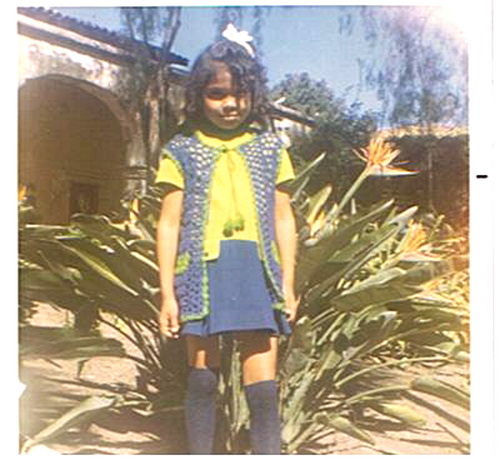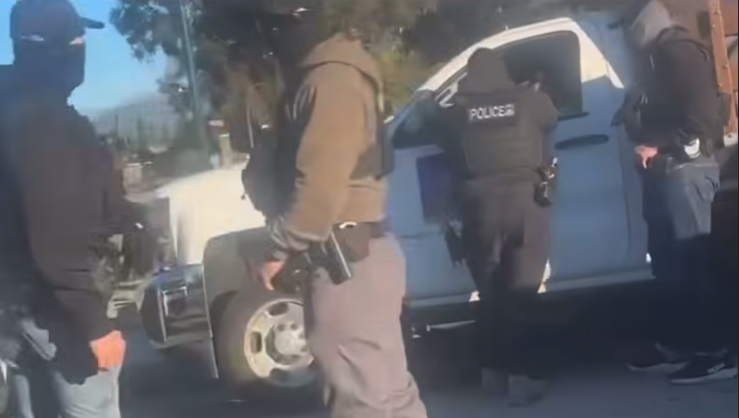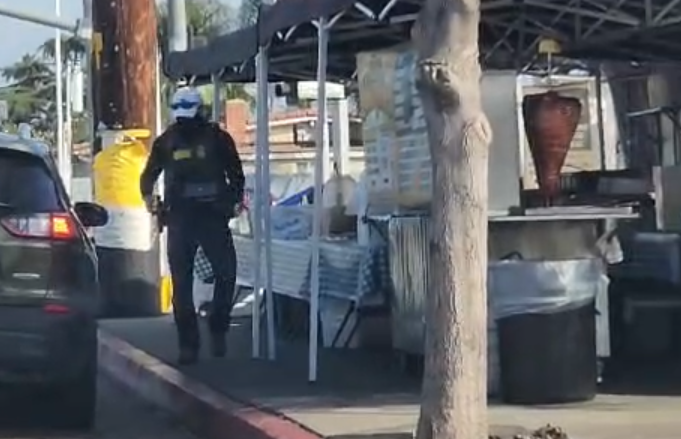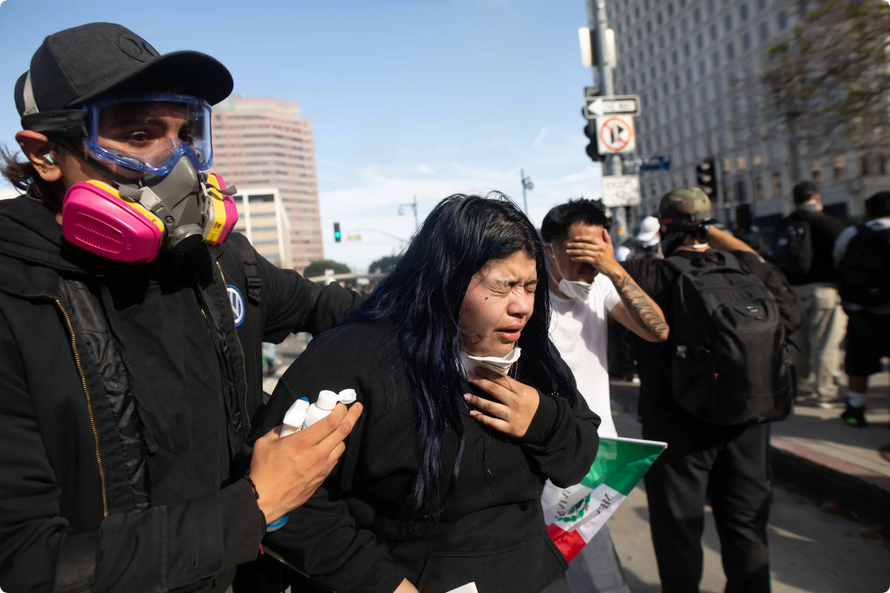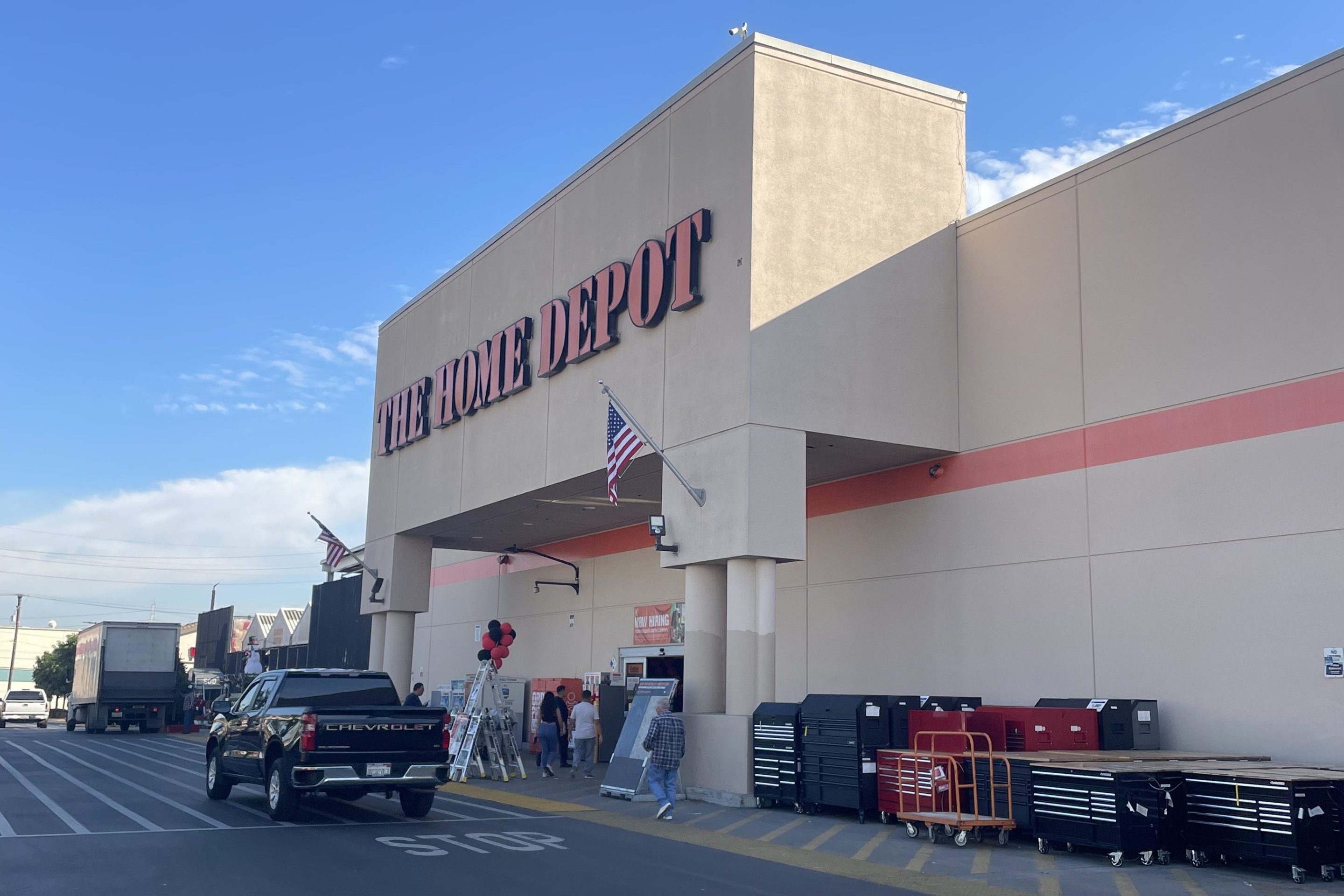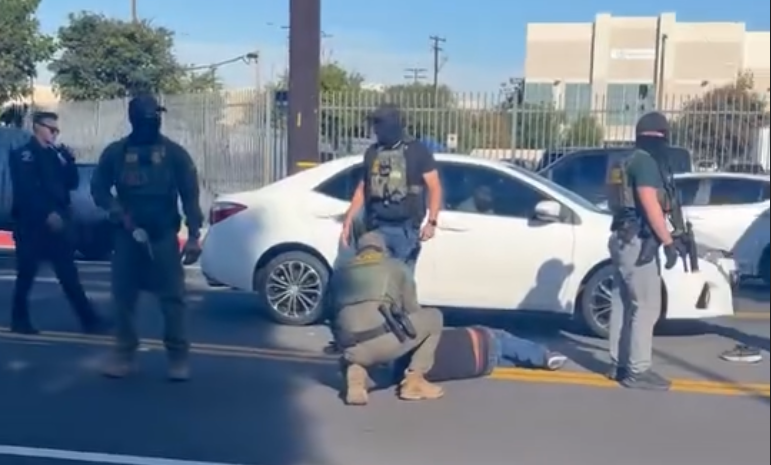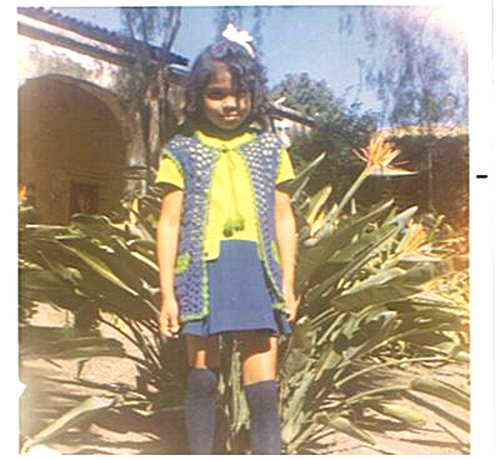
Pre-Zan days for Rosanna Esparza of East LA.
I first met artist Rosanna Esparza Ahrens in early November of 2007 at the El Gallo Cafe when East LA was preparing for Dias de los Muertos. Rosanna is Sticky Rick's Artistic Director, a business created by her husband Rick Ahrens to connect the world's stickiest artists and provide them with their sticker printing needs. Rosanna and I met again recently at her home in her native East Los Angeles. This interview is the result of these two encounters.
TACO: By mistake I just went to meet you across the street at the El Gallo Bakery, but as soon as I entered the bakery I realized this was no mistake, I was totally swooned over by the sweet aroma and the welcome of a very unlikely character who tempted me to bite into, not an apple, but a voluptuous piece of bread. There was something blatantly erotic in that act. It was as if Death was challenging me to bite into flesh i.e. live fully! I've heard people say Dias de los Muertos is for people obssessed with death but this character seemed awfully alive to me... and definitely naughty!
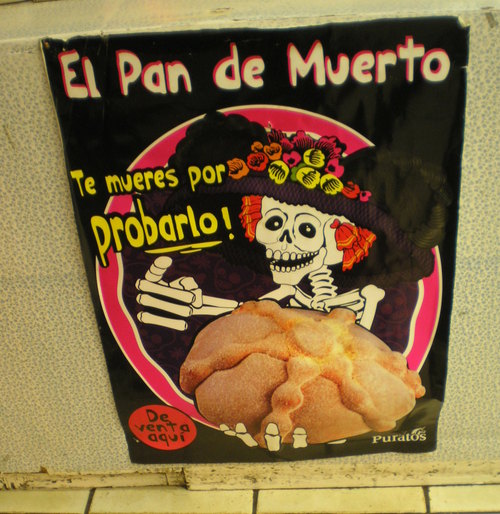
Rosanna Esparza Ahrens: I hear this too. But death is not something you can avoid, it's all around us. Look, the El Gallo Cafe where we are sitting right now is an old mortuary! (Laughs)
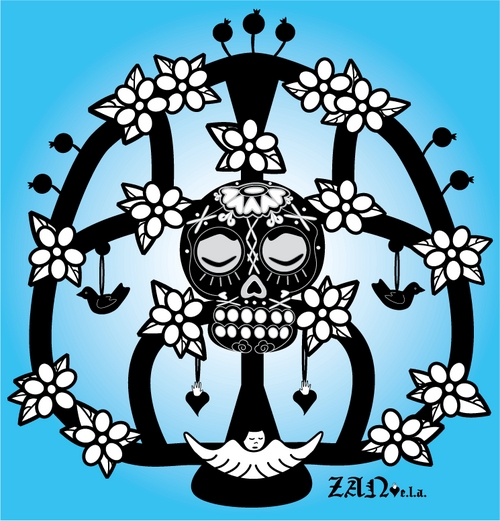
Blue Calavera by RoZANna.
TACO: There is a puzzling prevalence of skull imagery everywhere in LA, in fashion, bumper stickers, advertisement etc. but most of it is aggressive and charged. Your skulls are so incredibly peaceful. You come from a family of artists whose body of work spring mostly from the Day of the Dead tradition. Tell us about this early influence.
REA: My grandmother made her roots here from Mexico, she never called herself an artist but she truly was one. Her art was cooking and cake-making, she was the go to person for wedding cakes, any kind of cakes. She also drew. She made all these paper decorations, flowers, garlands for her Nativity installations at home. My grandmother made four altars a year, one for was for Sabado de Gloria, the Saturday before Easter and this one was always white representing the Resurrection; one for Dia de los Muertos, the other one was for Our Lady of Guadalupe which is December 12, and the fourth altar was for her Nacimiento or the Nativity installation. Except for the Nacimiento, my grandmother's altars were not big, they were just little niches up on the wall or on a table but their presence was always felt. On the other hand the nativity scene was a monumental altar which filled the whole living room, with everything to scale from Jesus, Mary and Joseph to dinosaurs and alligators. (laughs!)
My grandma collected figurines, they've been in the family for more than 70 years, some were imported from Italy, they're beautiful. She also had little pieces from Mexico. My grandma would make the nativity scene look like it took place in Mexico. It never looked like Bethlehem, I mean they weren't Hebrews, they were Mexicans! (laughs) My grandfather would build terraced platforms and lots of little villages. My mom, Ofelia, started painting backdrops on big canvas that looked like the night sky cityscape of Mexico City or Guadalajara.
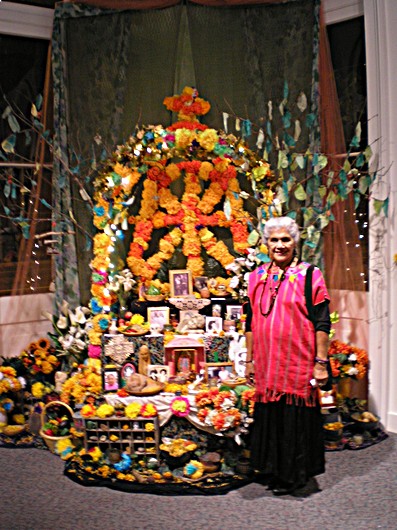
Artist Ofelia Esparza in front of the altar she designed for the 2007 Pico House's art exhibit: "Sacred memory: honoring the dead across cultures." Ofelia told me the altar wasn't truly completed until you lit the candles. But the fire regulations of the ancient Pico House prevented her from lighting them.
TACO: Were those backdrops the first art work your mother created?
REA: She'd already been drawing since she was a little girl but those paintings were an accomplishment, they were beautiful with the church tops, the domes and the mountains, the North star.
TACO: How old was she?
REA: Probably in her teens.
TACO: How did she go from doing altars at home to making these large community altars she's famous for?
REA: When Self Help Graphics relocated at its current location in 1979 my mother volunteered to teach art workshops to the kids from the community; she also participated in the printmaking classes. The Dia de los Muertos and other Art Exhibits lent themselves to the altar installations. When the founder, Sister Karen Bocalerro, died, my mother was asked to head the special community altar for the beloved Sister. There were so many people bringing tokens of love and rememberance the installation was monumental. Roughly about then she started making these gigantic altars every year which are displayed in several locations in and around East LA and get dismantled when the celebrations are over. My mother has also been commissioned to design Day of the Dead altars in Glasgow (Scotland,) Chicago, San Francisco.
When you are building an altar, you are creating sacred space where you communicate to your loved one that they are still a part of you and your family. It's also a reminder that life is short and we will be together again soon. My grandmother communicated the meaning of the Dia de Los Muertos altars quite elegantly, when she referred to Las Tres Muertes (the Three Deaths): "The first one is when you breathe your last breath, the second one is when you're buried in the ground never to be seen on the earth again and the third one, which is the most dreaded, is when you're forgotten."
TACO: Sacred is the word especially in Los Angeles. To me LA is still a gold rush kind of town where people come to strike gold whether it's enough money to put food on the table for your family or striking a million dollar deal in Hollywood. It's great to look to the future but the downside is people get disconnected from their past and don't show interest in LA's past. The Day of the Dead altars which connect families, communities, and honor the land where they're buried and their past is in my opinion vital to the greater Angeleno community at large. It's no surprise East LA has the oldest cemetery in Los Angeles, the Evergreen cemetery. Do you know there is a running track around it they call RIP: Run in Peace!
REA: Being born here I never realized how significant this tradition was for my family's culture and the fact that my grandmother had been uprooted from Mexico, until I heard my mother gave a lecture at East Los Angeles College. She shared about going to the Calvary Cemetery, which is just right down the street, for Dia de los Muertos as a little girl with her mother and some cousins and they would dress up some of the grave sites even though they didn't have relatives there yet, but it was my grandmother's custom to be there for Dia de Los Muertos. Some headstones looked so lonely so they cleaned them up and adorned them with flowers.
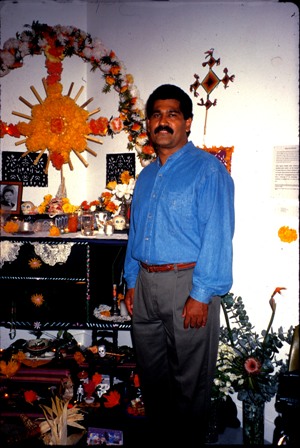
Brother Alec in front of one of the family shrines.
TACO: Now tell me how your whole family helps your mother with the creation of the community altars.
REA: My mother gets commissioned to design a certain amount of altars, she starts by sketching and shows my brother and I her renderings. We come up with ideas on how to achieve her vision. Let me make this clear, we don't give her any design tips at all. We help facilitate the making of the altars. She does give us some design freedom in there too but ultimately it's what she wants. First off we'll go shopping for fabric, that's a big project. We need to know how many altars she's making, the texture and setting she wants, the color schemes. She has an eye for it. My brother Javier is the builder, he makes the foundation or apparatuses, he's a sign hanger, he's got all the tools and he's great at it. My other brother Ben does anything from large format images and banners to specialized printing on various substrates. Between him and Javier and my brother Leonard they'll hang it. My mother, my sisters and I take care of the finishing touches, placing the bits and pieces on the altars but when it comes to final placement my mother is in charge, it all has to be in balance, not just the placement of objects on the altars but the colors. I've learned a lot from her.
Then we'll buy the tissue paper to make the flowers. It takes a lot of time. My mom makes most of them while she's watching TV, and anybody who's sitting there like her children or grandchildren will help her. I really enjoy this activity. It's a very social time similar to when my sisters and aunts get together to make tamales for the Christmas celebration. We also teach flower making workshops in the community. After an hour of teaching 10 people they start teaching more people. It's really cool to see the sense of accomplishment on the faces of the people we teach this art to.
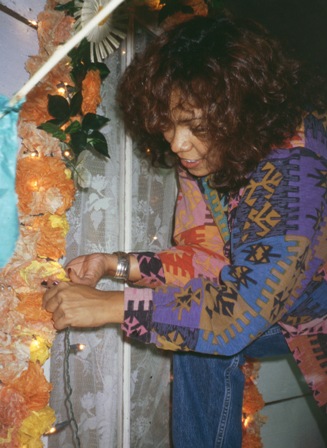
Rosanna and marigolds, 1999.
REA: The whole reason for Day of the Dead and altar making is the celebration of a mystical journey we all have to go through. That's why in the villages of Mexico the cemeteries are not far from the center of town or just on the outskirts so everybody builds their altars at home then go to the cemetery, dress up the graves with flowers and candles, spend the whole night there and it's like a big party in the cemeteries. Some of it is very reverent but then there is a very comical and festive aspect to it. Some families put the flower petals from the grave all the way to their door so the dead know where to go because that's where their ofrenda (offering/altar) is and their favorite things, like their favorite beer or mole. Families also put a glass of water for the dead because they're thirsty from walking such a long journey.
TACO: Have you continued the tradition? Do you do make altars in your home?
REA: Yes, I have this old vanity mirror with drawers on the side so it has little terrace areas, it's an altar for my husband's parents, my dad, my grandmother and godmother.
Right now I'm making marigolds out of tissue paper on stems and I'm going to put skull stickers and leaves on too. I want to sell them for Day of the Dead. Some people say "How can you be capitalizing on something like that?" I say, give me a break! No one is getting rich making and selling Day of the Dead arts and crafts. I think it's a beautiful thing to create things with your hands. I certainly appreciate handcrafted items to decorate my altar with. I would like to see Self Help Graphics have a Dia de los Muertos market place a few weeks before November 2nd, where people can come and shop for all the things they need to make their altars at home like flowers, candles, sugar skulls, calavera nic-nacs, painting, santos (saints,) religious items, food toys, whatever you would put on your altar.

Marigolds with skulls. 2007 Day of the Dead celebration at Hollywood Forever cemetery. Photo by Justin Kees.
TACO: Let's talk about your current projects as an artist and your website: "Zan loves E.L.A." By the way where does the name Zan come from?
REA: In high school my best friends and I were very new wave, punk, and everybody had this one syllable nickname. My friend Patricia had the name Pat the Bra (Vra.) Bra was short for bracera or bracero, it was the name given to workers coming over the border legally for the Bracero Program in 1942. My nickname came from my name Rosanna or Sanna. My skulls are rather meditative, they are my Zen.
TACO: When I think Zan and your love for your community, I also think Zorro! (laughs)
REA: He was a hero, he protected the people but I don't see myself as Zorro, I'm not facilitating anything for anybody although I do want to promote the arts. It's funny though!
TACO: Let's talk about the ZAN line.
REA: It's a line of t-shirts and housewares and it's all focused on Day of the Dead. It will be that calavera (skull) on bandanas, t-shirts, pillows, tableware etc. Then there's Design Restoration which is called "Aunt Feddy's closet." Aunt Feddy is my mom, for Ofelia, that's her nickname. Her logo is the hummingbird with the heart. Design Restoration is taking vintage and used clothes and revisiting them, taking out tags, embellishing, making it a little more interesting. My mom is a very funky dresser, she's always dressed with ethnic wear, with the traditional huipil, the head scarf. She wears lots of flowers, prints, I wanted to bring that to jeans and shirts, and funkify them! It is my dream project and will eventually be on my website. I love fashion. My only regret is that I quit Fashion school to follow my husband when he moved to Hawaii.
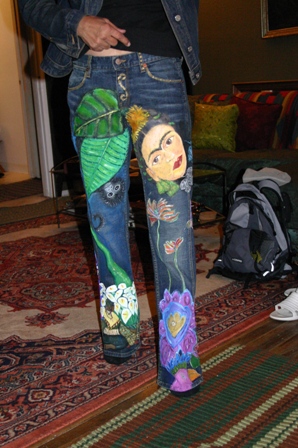
Funkyfied jeans by Rosanna.

Tropico de Nopal 2006 fashion show. Shawl designed and hand-crafted by Rosanna and modeled by her sister Elena. Photo by Gil Ortiz. Click here for Taco's coverage of the show.
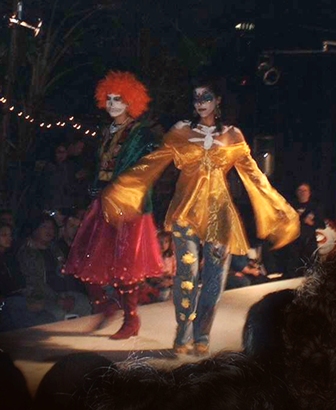
Tropico de Nopal fashion show. Hand-crafted jeans and jacket by Rosanna modeled by sister Elena and niece Monet.
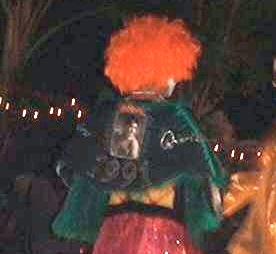
This shawl was designed in the memory of Rosanna's father.
REA: Zanlovesela.com is meant to be a community website where I can sell my arts and crafts but also where I invite people to look at other local artists' works. It has the connection with East LA even if these artists don't live here anymore as long as they emerged from here or have love for East LA. And it's not just about Chicano art, it's about art. It's not just low-riders even though it's one of those icons that gets associated with ELA, I mean my brother had a low-rider. I can identify with that icon but it's not everything.
There's definitely a huge diversity here. If you go down Eastern, you're going to run into a Chinese cemetery, which has really old graves, a Croatian and Serbian and a Jewish and Catholic cemeteries, just that in and of itself makes you question, why are the crosses different? That diversity has been here for 80 years.
TACO: What happened to the arts and crafts open market you were hoping for?
REA: The market got shut down I think it's a shame because it was a good place. There was always all this red tape and unfortunately no one in the community was available to take it on and say I'm going to own this.
My greatest concern today is the MetroLink that is coming through East LA. On one hand there is this terrific potential for new businesses to be started, which I welcome but I would love for the people of East LA to benefit from it, buy the commercial properties and open their own businesses. The 1st street store closed recently because it couldn't compete with the bigger stores. My mom had been to that store since she was a little girl and she is 75. When I was a little girl it was an old-time mom and pop department store, it looked big and magical to me, but of course it was actually a smaller department store. I remember having to stand on my tip-toes to look in the beautiful candy case and the aroma of the caramelized nuts. One of my sisters just wrote about this on my web site, on a page called "Stories from East LA." Over the years the department store went downhill. It's so sad it's gone, I don't know what they're going to do with the space but the last thing we need is another swap meet mall! Every hundred yard there is a 99 cts store here, they're just full of junk, people waste their money on disposable stuff. Sometimes you can find something useful but it's an eyesore to me.
My vision is to have what people are now calling an Art-walk down 1st street and have people come here and really see the art that is coming out of our community. The 1st street area could be a beautiful metropolitan place, a central part of East LA where you can come to look at art, get some coffee, pick up art supplies, sit and read a book. The El Gallo Cafe is great but it's an oasis, there are a lot of great spots here that people use and I never go to. I've only been here once. A lot of people have businesses on 1st street, on Soto, but the buildings are owned by really old families who purchased them 50 to 70 years ago. They will probably be bought by somebody from the outside and gentrified like parts of Downtown and the Arts District. I think it's a great thing to improve an area but I don't want to lose the texture and culture that is in the air.
Zan Loves East LA is going to be the virtual equivalent of this dream art walk to feature local artists, the neighborhood and buy art.

Altar to honor the life and passing of Sister Karen by Ofelia Esparza.
REA: That's what Self Help Graphics did for the community. It was opened here in the late seventies, in a different location. Karen Bocalerro, the founder, was one of the nuns from the local convent and an artist, a printer, who decided she was going to teach adults and kids the art of printimaking. The artists she helped break out into international acclaim are Gronk, Diane Gamboa, Leo Limon, Willie Heron, Reyes Rodriguez & Linda Vallejo to name a few.
Cheech Marin of the 1980's comic duo Cheech and Chong is a huge collector of Chicano art; his collection traveled around the world and it was published into a book called "Chinaco Visions: American painters on the verge." Right now it is on exhibit in Santa Ana. It features the artists I have just named and many more who came from SHG. Unfortunately, it came to a point a couple of years ago where the Board decided to close down Self Help Graphics. It triggered a huge protest. A group of artits formed a coalition, held the Board's feet to the fire and asked where the money went. They also came up with a strategic plan and offered help. Our form of protest was to have a Day of the Dead march around SHG, we decorated our vehicles and floats, we were walking altars that day, it was really cool. That was 2 years ago. SHG is still struggling to get funding.
Currently they're going back to the basics, back to how they got started, back to printmaking, bringing in established and emerging artists and creating a body of work that will foster the interest of collectors. They also do serigraphs, the process is really an art. The combination of talent between the artist and the printer creates the print. It's a tedious process that involves handpainted acetates and many tryouts. Joel Alpuche is the master printer.

Detail of Pico House Day of the Day altar by Ofelia Esparza, 2007.
TACO: Is it a dying art?
REA: I would not say it is a dying art but it is truly a very precise skilled art. Joe's son is his apprentice, I would love for them to do an apprenticeship program for people to learn this very special craft.
I was also thinking of applying for a grant from the City's Education Department to create an educational program that would bring Muralists into School Assemblies and give a presentation on exactly how the murals in their neighborhoods came about to prevent kids from tagging and just doing vandalism. By tagging I mean when you spray paint your name and your friend's names on a wall and it's not beautiful. Don't cover a mural, murals are part of our Chinaco history in East LA. Murals were part of a movement in the seventies opposing the war. Lots of political and cultural messages came out of that, they are priceless. Some of these kids are transplants from Central America and unfortunately those murals don't mean anything to them. There is a huge disconnect between the families who live here now and the recent history of our community. The rich Chinaco history can fade with the murals if we don't do anything about it.
My theory is also that in the late seventies Proposition 13 took away funding from public services like education. The student/teacher ratio grew dramatically, and of course art and music were the first classes to be cut from the curriculum. That was a big mistake, my feeling is art has to come back in the curriculum, because it's been missing for 30 years. If you're not exposed to art through your family as a mode of self expression and you don't get the exposure in school, the result is this disconnect with the murals where kids write right over them and for someone like me it makes no sense at all.
(Note: Unfortunately the 2008 California Budget includes major cuts in education.)

Zan in Matisse's red room. Self portrait. Digital art, 2007.
Visit www.zanlovesela.com to share your Stories of East LA and take a look at her newly opened e-store...
and for more interviews by frankiely for Taco, go to my blog.
